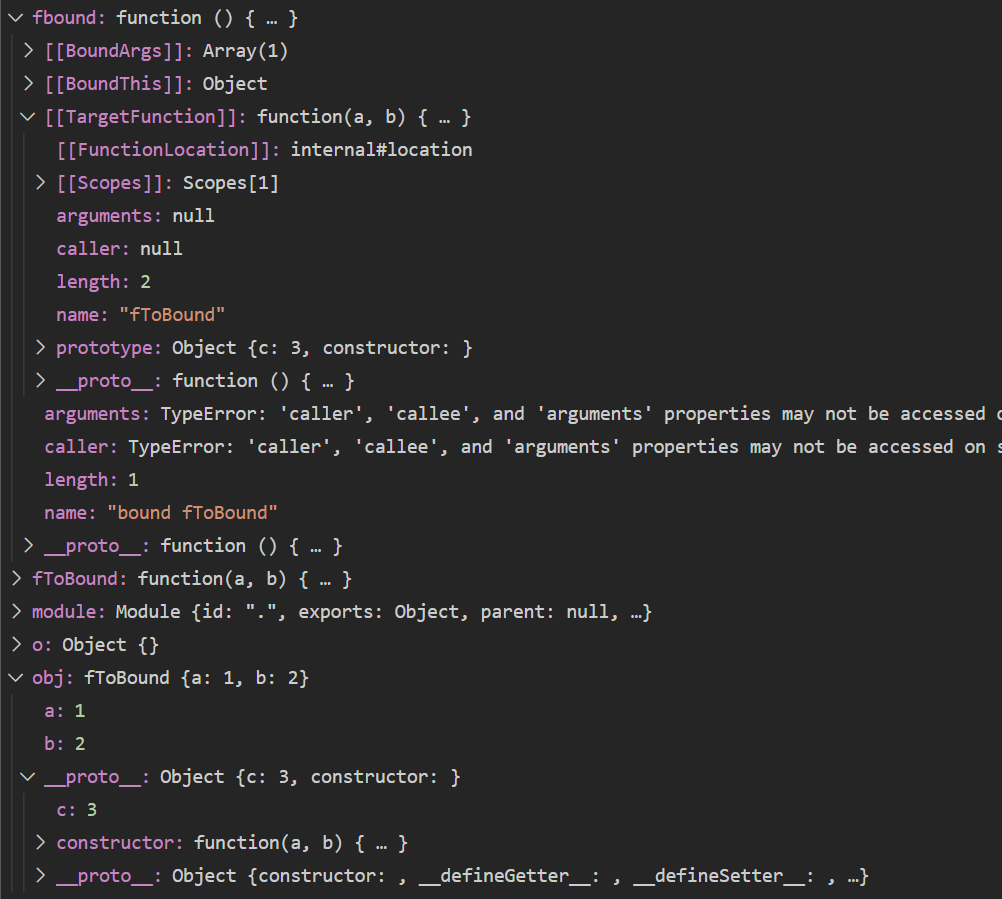bind
语法:
function.bind(thisArg[, arg1[, arg2[, ...]]])1
bind()返回一个绑定函数(bound function,BF),绑定函数可看做原函数的拷贝,并拥有指定的 this 值和初始参数,bind函数特点:
bind()方法创建一个新的绑定函数。绑定函数是一个 exotic function object(怪异函数对象,ECMAScript 2015 中的术语),它包装了原函数对象。在bind()被调用时,这个新函数的 this 被指定为bind()的第一个参数,而其余参数将作为新函数的参数,供调用时使用。- 绑定函数(怪异函数对象)没有 prototype 属性,但是能使用 new 操作符创建对象。这种行为就像把原函数当成构造器,提供的 this 值会被忽略,但前置参数仍会提供给模拟函数。
绑定函数 #
let fToBound = function(a, b) {
this.a = a
this.b = b
}
fToBound.prototype.c = 3
let o = {}
let fbound = fToBound.bind(o, 1)
console.log(fToBound.name) // fToBound
console.log(fbound.name) // bound fToBound
let obj = new fbound(2)
console.log(obj.constructor === fToBound) // true
console.log(obj.__proto__ === fToBound.prototype) // true
console.log(obj.c) // 3
1
2
3
4
5
6
7
8
9
10
11
12
13
14
15
16
17
18
2
3
4
5
6
7
8
9
10
11
12
13
14
15
16
17
18
vscode 调试面板查看绑定函数 fbound 和 obj:

由上可知,绑定函数有如下特点:
- 绑定函数有如下内部属性:
[[BoundArgs]]:前置参数数组,对包装函数做任何调用都会优先用数组元素填充参数列表[[BoundThis]]:调用包装函数时始终作为this值传递的值[[TargetFunction]]:包装的对象函数
- 绑定函数没有 prototype 属性
- 绑定函数的 name 属性等于 bound 加上原函数的 name
- 绑定函数被 new 构造调用时相当于把原函数当做构造函数
当调用绑定函数时,它调用 [[TargetFunction]] 上的内部方法 [[Call]],就像这样 Call(boundThis, args)。其中,boundThis 是 [[BoundThis]],args 是 [[BoundArgs]] 加上通过函数调用传入的参数列表。
polyfill #
if (!Function.prototype.bind) {
Function.prototype.bind = function() {
let fToBound = this // 缓存原函数
let boundThis = arguments[0] // 绑定函数的this值
let boundArgs = Array.prototype.slice.call(arguments, 1) // 绑定函数的前置参数数组
/**
* bind只能被函数调用
*/
if (typeof fToBound !== 'function') {
throw new TypeError('Function.prototype.bind - ' + 'what is trying to be bound is not callable')
}
/**
* 绑定函数
* 绑定函数被new构造调用(this instanceof fBound为true)时,this不变
*/
let fBound = function() {
let _this = this instanceof fBound ? this : boundThis
let args = boundArgs.concat(Array.prototype.slice.call(arguments))
return fToBound.apply(_this, args)
}
/**
* 维护原型关系
* 绑定函数标准上是没有prototype,绑定函数被new构造调用相当于把原函数当做构造器,因此
* polyfill时需要将绑定函数的prototype指向原函数的prototype
*/
if(fToBound.prototype) {
/**
* 和标准保持一致,使用fBound.prototype = fToBound.prototype,因为
* let obj = new fBound()
* obj.__proto__ === fToBound.prototype // true
* 风险就是修改fBound.prototype就是修改fToBound.prototype
*/
fBound.prototype = fToBound.prototype
// fBound.prototype = Object.create(fToBound.prototype, {
// constructor: {
// value: fToBound
// }
// })
}
return fBound
}
}
1
2
3
4
5
6
7
8
9
10
11
12
13
14
15
16
17
18
19
20
21
22
23
24
25
26
27
28
29
30
31
32
33
34
35
36
37
38
39
40
41
42
43
44
45
46
47
2
3
4
5
6
7
8
9
10
11
12
13
14
15
16
17
18
19
20
21
22
23
24
25
26
27
28
29
30
31
32
33
34
35
36
37
38
39
40
41
42
43
44
45
46
47
